
Cupressus bakeri, reclassified as Hesperocyparis bakeri, with the common names Baker cypress, Modoc cypress, or Siskiyou cypress, is a rare species of cypress tree endemic to a small area across far northern California and extreme southwestern Oregon, in the western United States.
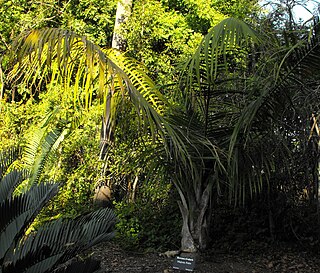
Ravenea is a genus of 20 known species of palms, all native to Madagascar and the Comoros.
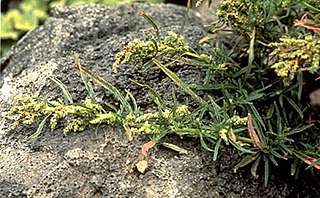
Amaranthus brownii was an annual herb in the family Amaranthaceae. The plant was found only on the small island of Nihoa in the Northwestern Hawaiian Islands, growing on rocky outcrops at altitudes of 120–215 m (394–705 ft). It was one of nine species of Amaranthus in the Hawaiian Islands, as well as the only endemic Hawaiian species of the genus. It is now considered extinct.
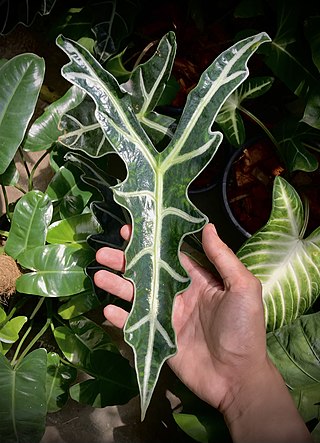
Alocasia sanderiana, commonly known as the kris plant or Sander's alocasia, is a plant in the family Araceae. It is endemic to Northern Mindanao in the Philippines, but is commonly grown as an ornamental plant worldwide. It is classified as critically endangered in the wild by the International Union for Conservation of Nature.

The Philippine tube-nosed fruit bat locally known in Tagalog as Bayakan is a species of bat in the family Pteropodidae. It is endemic to the Philippines and known from the islands of Cebu, Negros and Sibuyan. It occurs in and near primary and secondary subtropical or tropical dry forests. It is often found near water. The species is named for Dioscoro S. Rabor who, with several others, first collected the species.
Ardisia koupensis is a species of plant in the family Primulaceae. It is endemic to Cameroon. Its natural habitat is subtropical or tropical moist lowland forests. It is threatened by habitat loss.

Eugenia haematocarpa is a rare species of plant in the family Myrtaceae. It is endemic to Puerto Rico. It is classified as an endangered species by the U.S. Fish and Wildlife Service and there has been a plan for its recovery in place for some years. Its common names include uvillo and Luquillo Mountain stopper.
Renauldia lycopodioides is a species of moss in the family Pterobryaceae. It is endemic to Tanzania, where it is known from only two locations and is considered an endangered species. It grows on tree branches in forested habitat. It is threatened by deforestation.
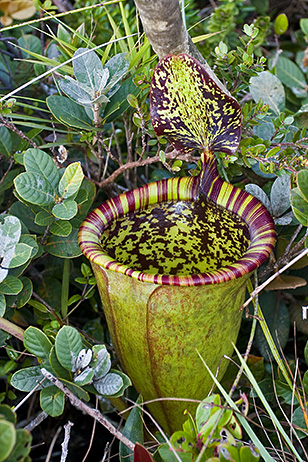
Nepenthes attenboroughii, or Attenborough's pitcher plant, is a montane species of carnivorous pitcher plant of the genus Nepenthes. It is named after the celebrated broadcaster and naturalist Sir David Attenborough, who is a keen enthusiast of the genus. The species is characterised by its large and distinctive bell-shaped lower and upper pitchers and narrow, upright lid. The type specimen of N. attenboroughii was collected on the summit of Mount Victoria, an ultramafic mountain in central Palawan, the Philippines.
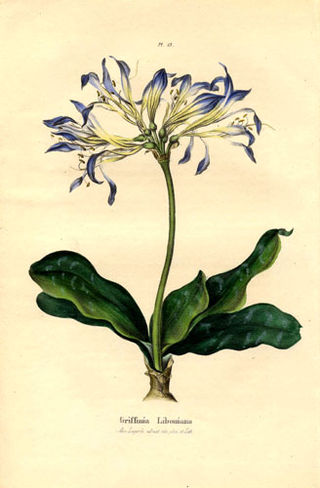
Griffinia is a genus of Brazilian plants in the Amaryllis family, subfamily Amaryllidoideae. It includes 23 known species which are endemic to Brazil. The most closely related genus to it is the monotypic Worsleya.

Cornutia obovata is a rare species of tree in the mint family, and formerly considered a member of the verbena family. It is endemic to forested slopes in Puerto Rico, where its common names are capá jigüerilla, nigua, and palo de nigua. When it was added to the endangered species list of the United States in 1988 there were only seven individuals known to remain in the wild. By 1998 there were eight plants known. This is considered one population divided amongst a few locations in the mountain forests of the island.
Dubautia kenwoodii, the Kalalau rim dubautia, is an "extremely rare" species of flowering plant in the family Asteraceae. It is endemic to Hawaii where it is known only from the island of Kauai. Only one plant has ever been seen: the type specimen. A part of this plant was collected in 1991 and the individual was described as a new species in 1998. It was federally listed as an endangered species of the United States in 2010. Like other Dubautia this plant is known as na`ena`e.

The Kashmir musk deer is an endangered species of musk deer native to Afghanistan, India, and Pakistan. Recent studies have shown that the species is also native to western Nepal. This species was originally described as a subspecies to the alpine musk deer, but is now classified as a separate species. The deer stand at 60 cm (24 in) tall, and only males have tusks and they use them during mating season to compete for females.

The Luzon rain forest is a tropical moist broadleaf forest ecoregion on the island of Luzon. Luzon is the largest island in the Philippines, and the Luzon rain forest is the most extensive rainforest ecoregion of the country. The ecoregion includes the lowlands of Luzon and neighboring islands below 1000 meters elevation. Very little of the original rainforest remains, and the status of this area is critical/endangered.

Quercus insignis is a Mesoamerican species of oak in the white oak section, within the beech family. It is native to southern Mexico and Central America, from Veracruz to Panamá.
Drepanolejeunea senticosa is a species of liverwort in the family Lejeuneaceae. It is native to Cuba. The species is listed as critically endangered by the IUCN.
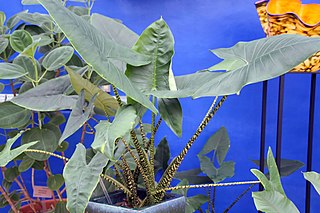
Alocasia zebrina, commonly known as the zebra plant or zebrina alocasia, is a plant in the family Araceae. It is endemic to the islands of Luzon, Mindanao, Leyte, Samar, Biliran, and Alabat in the Philippines. It is commonly grown as an ornamental plant worldwide. It is also locally known as gabing tigre in Tagalog. It is nationally listed as a threatened species and collection of A. zebrina from the wild is illegal in the Philippines.
Alocasia atropurpurea is a flowering plant in the family Araceae endemic to northern Luzon in the Philippines. It is classified as Critically Endangered by the IUCN Red List of Threatened Species and has only been recorded in Mount Polis and an unspecified locality in the Mountain Province.

Cryptocarya elliptifolia is a species of small evergreen tree in the family Lauraceae. It is native to the Philippines and Orchid Island in Taiwan. It is classified as Critically Endangered by the IUCN Red List of Threatened Species.

Dendrobium schuetzei, sometimes called Schuetze's dendrobium, is a species of orchid endemic to northeastern Mindanao, Philippines. Though widely grown as an ornamental, it is classified as Critically Endangered by the IUCN Red List of Threatened Species due to habitat loss and unsustainable harvesting from the wild.















